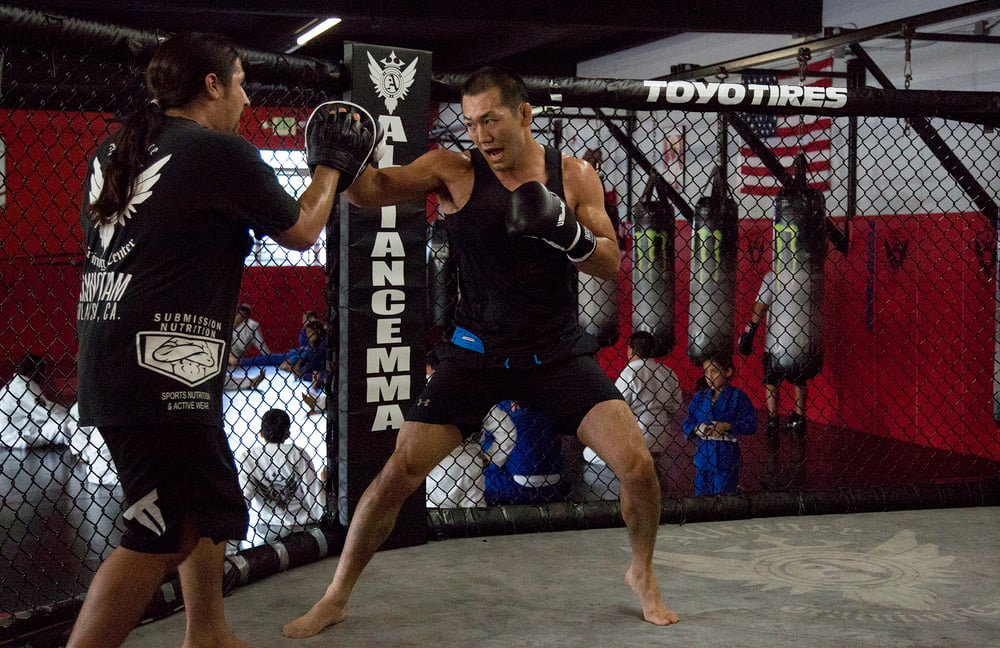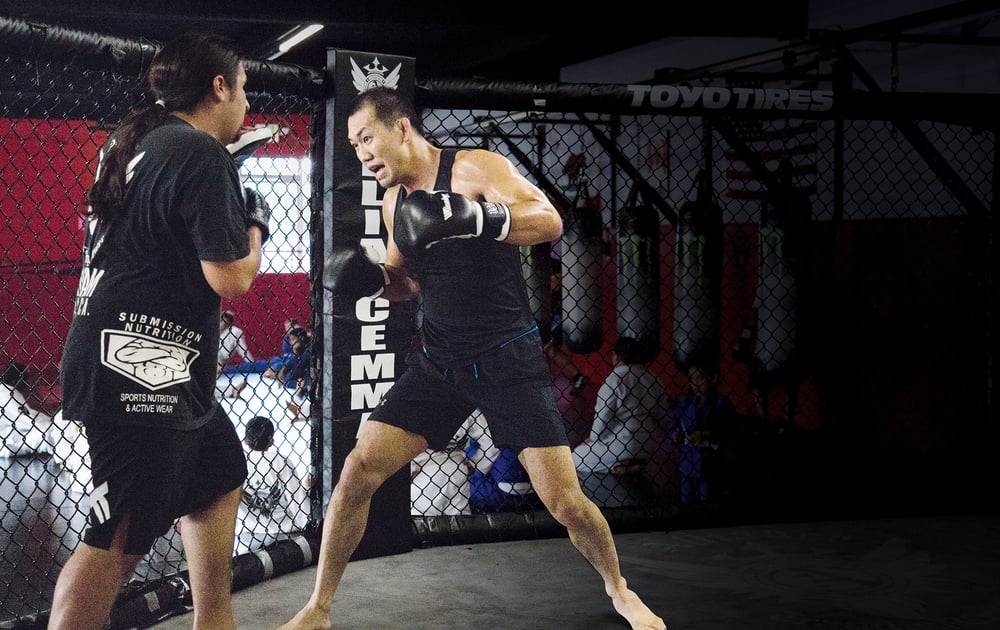
Issue 107
November 2013
After initially moving to the US to train alongside Chael Sonnen, the former UFC middleweight title challenger invites FO into his new camp based at Alliance MMA in San Diego, California.
Talk about life being a rollercoaster: just look at some of the ups and downs Yushin Okami has had to deal with since moving to the US.
He was almost shot by Chael Sonnen’s title-winning, trap-shooter mother. He challenged, albeit unsuccessfully, for the UFC belt. He then suffered a painful TKO defeat to Tim Boetsch in the UFC’s heralded return to Japan. And now he’s once again forced his way back up near the top of the 185lb rankings.
It was after his October 2009 loss to Sonnen that Okami switched his training camps from his native Japan to the West Coast. Buddying up with Sonnen and Matt Lindland at Team Quest, Okami then notched up three consecutive wins – including the scalps of ranked contenders Mark Munoz and Nate Marquardt.
The run led to a return with Anderson Silva and a chance to capture UFC gold. Yet Anderson, who had lost via disqualification to Okami in their pre-UFC days back in 2006, was at his mercurial best, and Okami’s run at the belt came crashing to an end.
‘Thunder’ looked to bounce back at UFC 144, the first event the organization had held in Japan in 12 years. But the black belt judoka failed to put ‘Barbarian’ Boetsch away after two totally one-sided rounds and paid the price in the third, when a flurry of uppercuts led to a TKO defeat.
But you can’t keep a good man down, and Okami has bounced back with another trio of wins. Successive victories against Buddy Roberts, Alan Belcher and Hector Lombard have lifted Yushin back among the leading contenders at 185lb. Yet he’s not resting on his laurels and has switched camps to the Alliance team in Chula Vista, California.
Okami hopes it will prove to be the move that takes his skills to the very next level. And with a fight against ‘Jacare’ Souza scheduled for Brazil on September 4th, he didn’t have to wait long to find out. FO spent the day inside Okami’s new fight camp, and discovered that, although his English is minimal, Okami’s impact and professionalism is proving infectious.
WARM-UP
Born and raised in Japan and with judo in his armory, traditional martial arts have always been a major part of Yushin’s life and not surprisingly he also uses his warm-up routine as something of a meditation session. The 32-year-old likes to spend at least 45 minutes warming his body, and centering his mind prior to training.
“Any warm-up, even for the first day of training, is very important. If you don’t warm-up correctly you will get injured,” he admits. “I also like that time to be a quiet time – no talking. A time when I can prepare myself for the challenge training brings.”

PADS
Timing is everything inside the Octagon and there’s no better way to sharpen your striking skills than by hitting mitts. It’s something Okami admits he enjoys most about training camp; and the array of coaches he’s worked with, both across his native Japan and the West Coast US, during his fighting career have all added something to his arsenal.
“Striking is something I enjoy,” he says, which is perhaps somewhat surprising seeing as he’s a black belt judoka. “It’s a part of fighting that I continue to improve on with every class, and it’s easy to see how you are sharpening up your punching as a fight draws near.”
NUTRITION
As a big middleweight, Okami has been known to blow up between fights. “After my loss to Anderson I was as heavy as 220lb,” he recalls, so nutrition has begun to play an increasingly important role in his training program.
And the former title challenger admits he’s actually found it easier to manage his weight since moving to the US full-time. He says: “The chicken here is really dry, it doesn’t have the fat of chicken in Japan. And the beef is all lean, so the foods in the US are far better than Japan for losing weight. The plan for camp is always to take in a little bit of fat, really cut down on carbs, and get a lot of protein; so being in America actually helps.”

EXPLOSIVE STRENGTH AND CONDITIONING
Working with Institute for Human Kinetics kinesiologist Chad Macias, Okami focuses a lot on explosive S&C techniques, moving from a resting position in to a rapid burst of energy. “I am trying to teach Yushin’s body to be able to generate energy through the amortization phase of an explosive movement,” says Chad. “That way very little energy is lost and the potential for generating concentric power will increase as a result.” Here, Chad explains the science behind four of Okami’s regular drills:
Seated box jump
“From a seated position, Yushin explodes in to the box jump. Where, typically, energy is lost in the transfer from eccentric to concentric explosive movement, starting seated minimizes this energy waste. Yushin also lands soundly, keeping the arms and hands in alignment to maintain a neutral spine position. This way the connective tissue is forced to absorb the energy of the landing, which helps increase his ability to store energy.”
Seated to toe touch
“Again starting seated, Yushin explodes up using the posterior chain heavily to touch his toes. Yushin is very explosive and gets pretty good air. When doing these you are leaving from the complete seated position, not slightly standing up and then jumping. You must explode from the seated position, and it’s a very difficult exercise.”
Chest, shoulder and biceps routine
“Here we are increasing the density of the contractile components, but with little change to the overall volume of the muscle. This involves a slow eight-second eccentric lengthening phase and an explosive concentric phase of the contraction. Looking at my athletes you’ll notice they all have similar physiques, which shows they have good balance, strength and symmetry, which when combined makes them much more resistant to injury.”
Sprints
“Here, Yushin is performing eight sets of four 100-meter sprints with little rest. His blood lactate reading afterwards of only 9.3mm per deciliter of blood or mm/dl is pretty remarkable, and it shows he has both a very good aerobic base and very good anaerobic efficiency. This is after seven weeks of my bio-energetic training (conditioning work).”
...









